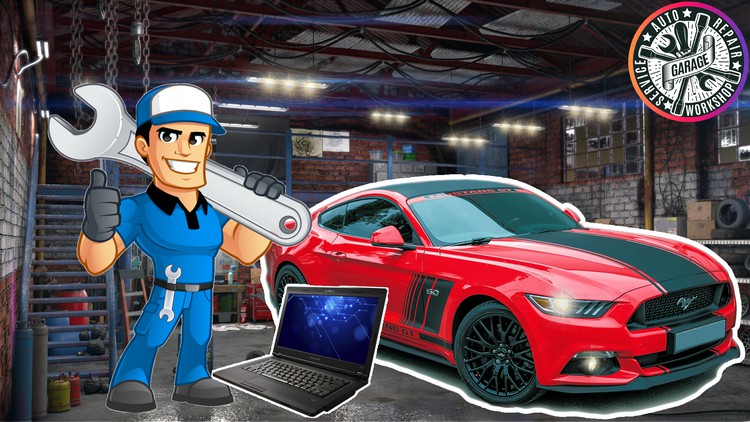
Learn Car Repair, Maintenance, Automotive one course and be Pro on cars. Build your Garage & start your dream job. 2021
☑ Car Parts and Engine System
☑ Different Engine Types
☑ Electricity Fundamentals
☑ Car Electronic Components
☑ Chassis System and Car Body
☑ Car Suspension System
☑ Buzzers, Relays, Batteries, Switches and other Electronic Components
☑ Microcontrollers
☑ Camber and Castle Angle, Toi-in and Toe-out
☑ Transmission Fundamentals
☑ Manual, Automatic and CVT Transmission
☑ Electronic Circuits
☑ Electrical Control Unit (ECU) Inspecting and Hacking
☑ Car Spark Plugs
☑ Building your Car Repair Shop
☑ Car Oil Change
☑ Reprogramming Key Immobilizer
☑ ECU Tuning
☑ Car Fluid Check
☑ Car Exhaust System
☑ Chip Tunning Stages
☑ Car Brake System
☑ Working With CAN Bus
☑ Can BUS Fundamentals
☑ Can Fuzzing
☑ OBD II / OBD 2 Diagnostics
☑ Car Turbo
☑ Car Key Programming with IM600
☑ Car Key Programming with PC / OBD2
☑ ECU Firmware Backup with KTAG
☑ Car Lighting System
☑ Opening your own GARAGE
☑ and Lots of other Awesome Lectures —>
*Printable online certificate available upon completion of course*
One of the things that I find most interesting about automotive technology is how it advances and changes. It is also interesting that ideas from many years ago often return to favour. In this course I have therefore concentrated on core technologies, in other words how the technology works, rather than giving too many examples from specific vehicles. However, I have included some examples of Formula 1 technology, arguably the pinnacle of automotive engineering. Did you know that the 2011 McLaren MP4-26 F1 car is made of 11500 components? And that’s counting the engine as one!
- Why Every Car Technician Should Know Electricity in Cars ?
In the past it was possible for technicians to work their entire careers and be able to almost completely avoid the vehicle’s electrical systems. They would specialize in engines, steering/suspension, or brakes. Today there is not a system on the vehicle that is immune to the role of electrical circuits. Engine controls, electronic suspension systems, and antilock brakes are common on today’s vehicles. Even electrical systems that were once thought of as being simple have evolved to computer controls. Headlights are now pulse-width modulated using highside drivers and will automatically brighten and dim based on the light intensity of oncoming traffic. Today’s vehicles are equipped with twenty or more computers, laser-guided cruise control, sonar park assist, infrared climate control, fiber optics, and radio frequency transponders and decoders. Simple systems have become more computer reliant.
Even the tires have computers involved, with the addition of tire pressure monitoring systems!
Today’s technician must possess a full and complete electrical background to be able to succeed. The future will provide great opportunities for those technicians who have prepared themselves properly.
- Car Tuning
Cars are literally the vehicles by which we see the world, and by which the world sees us. Second in value only to the homes in which we live, cars are the reflection of who we are when we are in transit — out in the world commuting to work or having fun on the weekend. They are also the closet bond most people ever form with a machine. We think a movement, and the car translates that thought, that impulse, into action. The car becomes an extension of ourselves. Few things are as often mutually desired and accessible as an automobile. With that possession comes opportunity, as some folks see it, to do something different. Something cool. As cars become more and more alike with each passing model year, the drive for owners to individualize them grows increasingly stronger. We want to feel something towards our cars.
- Car ECU Hacking and Tuning
This Chapter of our Course walks you through what it takes to hack a vehicle. We begin with an overview of the policies surrounding vehicle security and then delve in to how to check whether your vehicle is secure and how to find vulnerabilities in more sophisticated hardware systems.
The automotive industry has churned out some amazing vehicles, with complicated electronics and computer systems, but it has released little information about what makes those systems work. Once you understand how a vehicle’s network works and how it communicates within its own system and outside of it, you’ll be better able to diagnose and troubleshoot problems.
English
Language
Introduction
The Role of Electricity in Automobiles
Car Parts and Engine System
Anti-Theft and Car Security Systems
Car Computers
Car Starting System
Car Charging
Car Lightning System
Understanding Electiricty
Electricity Fundamentals
Conductors and Isulators
Current
AC & DC
Ampere
Watt (Power)
Voltage
Car Electronic Components and Wiring
Electrical Components Introduction
Batteries
Blade Fuses
Buzzers
Relays
Resistors
Switches
Microcontrollers
Chassis and Car Body
Wheel and Tyres
Brakes
Suspension
Camber and Castel Angle, Toe-in and Toe-out
Steering
Automobile Transmission
Transmission Fundamentals
Transmission Clutch
Manual Transmission
Automatic Transmission
CVT Transmission
Diagnostics
OBD II Port
ELM327
ECU Hacking
ECU Fundamentals
ECU Power Management
Automobile Sensors
Automobile BOSCH ECU Inside
CAN Bus Fundamentals
CAN Fuzzing
Brand tools vs Manual Hacking & J2534
Troubles and Solutions when working with ECU and CAN Bus
Car Key & Immo Programming
How Immobilizer Works
Key Programming in Action & Overview IM600